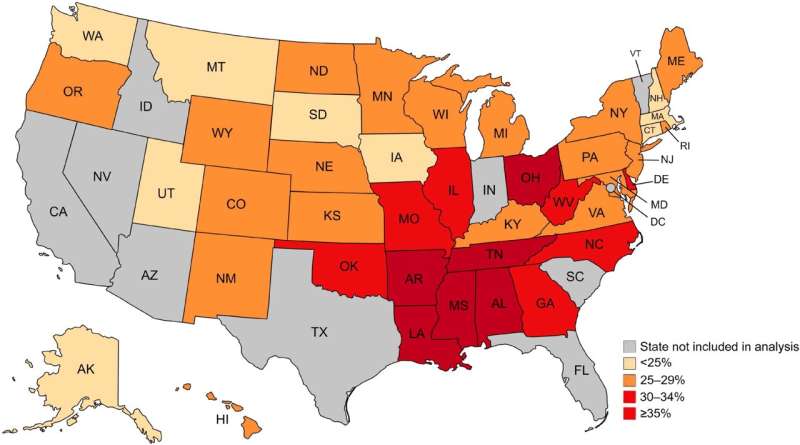This article has been reviewed according to Science X's editorial process and policies. Editors have highlighted the following attributes while ensuring the content's credibility:
fact-checked
peer-reviewed publication
trusted source
proofread
Stricter abortion laws linked to increase in unintended births

Prior to the overturning of Roe vs. Wade, women in states that severely limit or outlaw access to abortion were 13% more likely to have a live birth resulting from an unintended pregnancy than those in states where abortion care was more accessible, according to research from the Cornell Jeb E. Brooks School of Public Policy.
That figure is potentially even higher, as data was not available from several states that severely limit reproductive care, including Texas.
The researchers also found that the association between abortion-policy hostility and live birth due to an unintended pregnancy is particularly strong among women in younger, less educated, Medicaid, uninsured and rural populations. Those women are also at greater risk for maternal mortality, as well as health challenges for their babies.
"We know that these less advantaged women are more likely to experience health challenges and have higher rates of maternal mortality," said Sharon Sassler, professor and director of undergraduate studies in the Brooks School and co-author of "State-Level Abortion Policy Hostility and Unplanned Births in the Pre-Dobbs Era," which published Sept. 8 in Demography. "Their infants are also challenged—higher rates of low birth weight and higher rates of infant mortality."
Julia Eddelbuettel, now a first-year doctoral student at Harvard University, is lead author.
In the U.S., the total number of abortions and the abortion rate both peaked in the 1980s before steadily declining over the next four decades. Increased access to and use of contraception, due to policies including the Affordable Care Act, helped drive this decline in abortions, the researchers wrote.
Despite this trend, the most vulnerable sought abortion care at a higher rate than the general population. Among those with a family income below the federal poverty line, the proportion of women seeking abortions increased sevenfold between 2008 and 2014.
For their research, Eddelbuettel and Sassler used individual-level data from the Centers for Disease Control and Prevention's Pregnancy Risk Assessment Monitoring System survey of women who'd recently had a live birth, for the years 2012-18. A total of 42 states were included in the analysis.
Additional state-level data measured religiousness and the proportion of Republicans elected to the House of Representatives from a given area. Data on religiosity and political representation was obtained from the Pew Research Center and the Library of Congress, respectively. State-year-level legislative data on abortion restrictions was obtained from the Guttmacher Institute.
The researchers found that while the percentage of live births from unintended pregnancies (either mistimed or unwanted pregnancy) has decreased over the last 15 years, this decrease was not evenly distributed across the country. States with the highest levels of live births from unintended pregnancies were in the South and Midwest regions, while the lowest levels were found in the Northeast and West.
State characteristics—including share of population who attend religious services weekly, and higher shares of Republicans in the House of Representatives—were associated with greater likelihood of a live birth from an unintended pregnancy.
The paper also found that public policies mattered: Women living in states with a greater number of policies that made it difficult to access abortions—which were legal in all states prior to the Dobbs decision in June of 2022—experienced significantly higher levels of unintended pregnancies that resulted in a live birth than women living in states with fewer restrictive policies.
Many states with strict abortion regulations claim they are focusing on the children, but their actions haven't reflected that claim, Sassler said.
"Providing broader access to health insurance coverage, getting women prenatal care earlier on in their pregnancy, and extending insurance coverage for longer periods of time after they give birth is just one way of taking better care of women and children," she said.
Eddelbuettel began this research, which would become her honors thesis, as a sophomore majoring in policy analysis and management in the College of Human Ecology. She and Sassler presented the work at the 2022 Population Association of America annual meeting, during what would have been the spring of her senior year. She graduated in December 2021.
"Presenting at that conference is a highly competitive process," Sassler said. "It's incredibly rare for undergraduates to present there."
More information: Julia C. P. Eddelbuettel et al, State-Level Abortion Policy Hostility and Unplanned Births in the Pre-Dobbs Era, Demography (2023). DOI: 10.1215/00703370-10952575



















